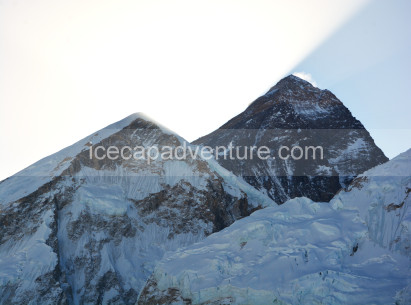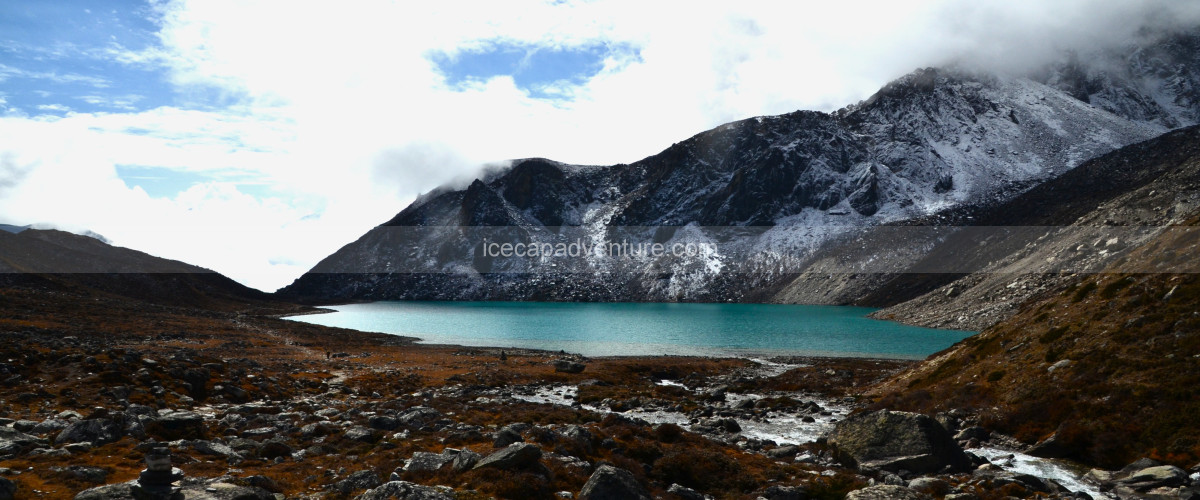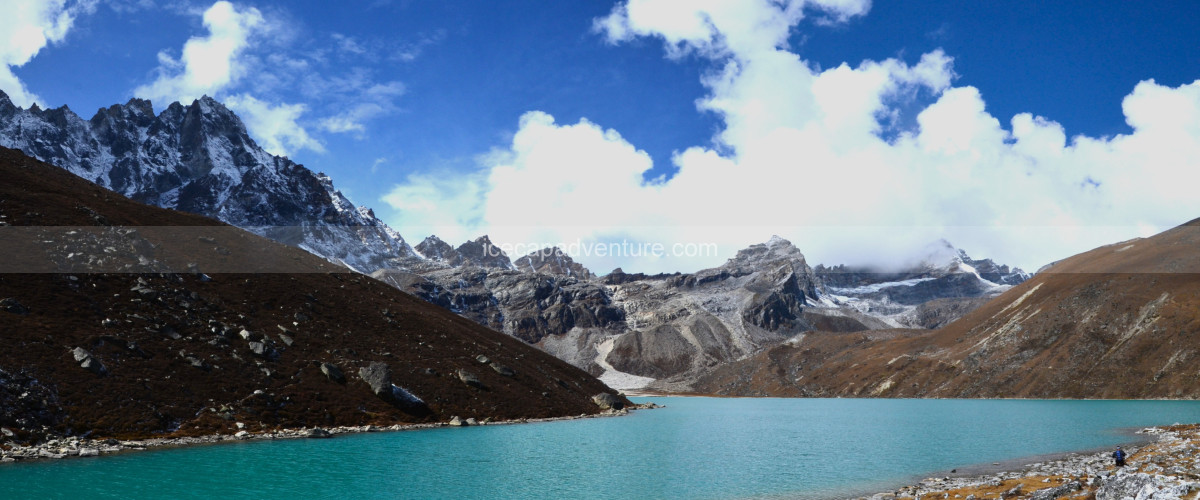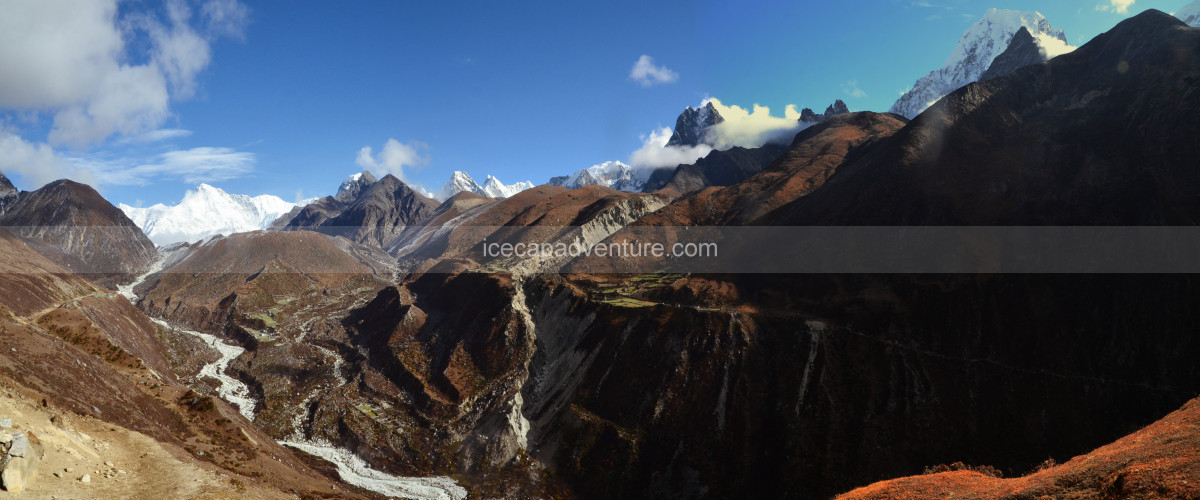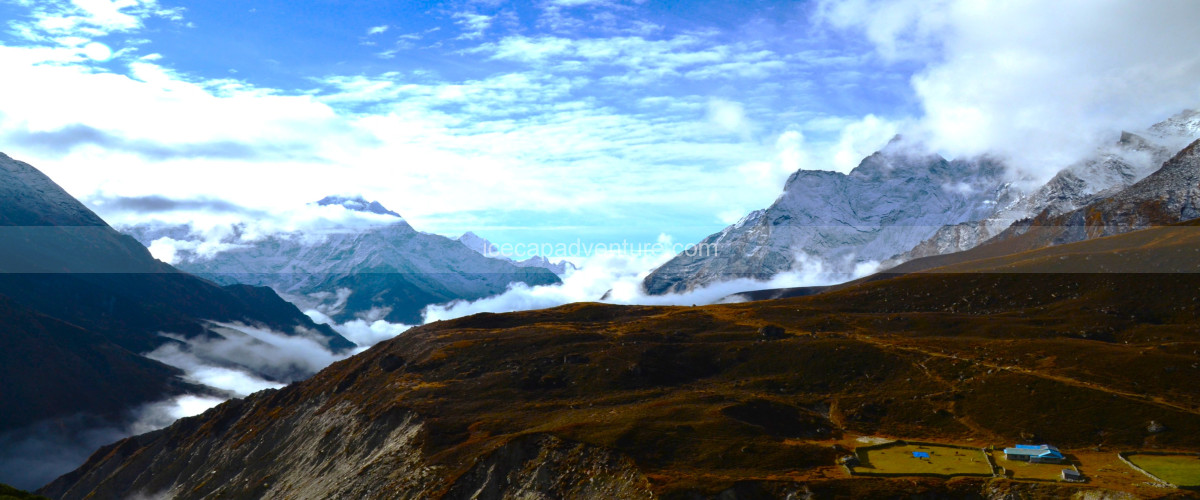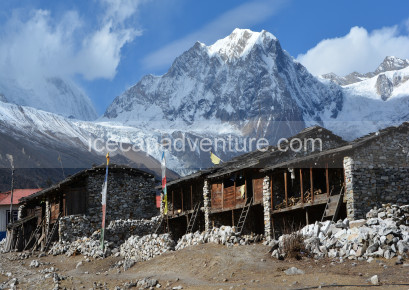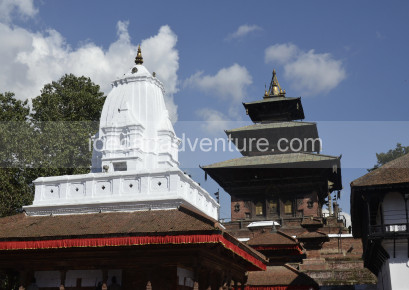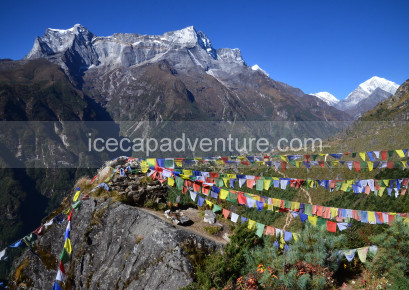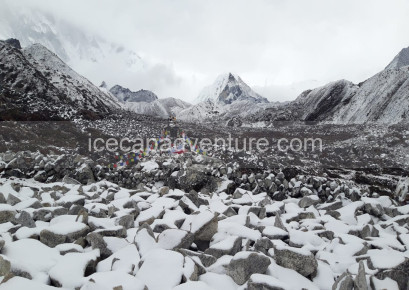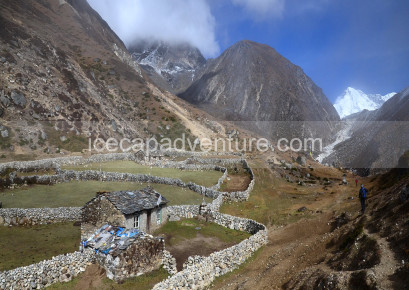.png)
.png)
.png)
.png)
.png)
.png)
.png)
.png)
Gokyo Lake Trek – Journey to Nepal’s Turquoise Himalayan Lakes
The Gokyo Lake Trek is one of the most enchanting journeys in the Everest region of Nepal, taking trekkers beyond the classic Everest Base Camp route to the serene and mesmerizing Gokyo Valley. This trek is famous for its chain of six glacial lakes, shimmering in shades of turquoise beneath the shadow of towering Himalayan peaks. The route offers an incredible blend of natural beauty, cultural encounters, and panoramic mountain views, making it a favorite for trekkers seeking tranquility away from the busier trails.
The highlight of the trek is the climb to Gokyo Ri (5,357m) — a magnificent viewpoint offering one of the best panoramic scenes in the Everest region. From here, trekkers can witness breathtaking vistas of Mount Everest, Lhotse, Makalu, Cho Oyu, and Ngozumpa Glacier, the largest glacier in Nepal.
Duration & Difficulty
The Gokyo Lake Trek typically takes around 12–14 days, depending on your pace and acclimatization schedule. It is considered a moderate trek, suitable for trekkers with good physical fitness and some prior hiking experience. The trails are well-defined, but the altitude can be challenging — making slow ascent and proper rest days essential.
Best Time to Trek
The best seasons for Gokyo Lake Trek are spring (March–May) and autumn (September–November). During these months, the skies are crystal clear, the mountain views are stunning, and the temperature is comfortable for trekking. The spring season adds an extra charm with colorful rhododendron blooms along the trails, while autumn offers crisp air and unbeatable visibility.
Route & Major Stops
The adventure begins with a scenic flight from Kathmandu to Lukla, followed by trekking through picturesque Sherpa villages such as Phakding, Namche Bazaar, Dole, Machhermo, and Gokyo. Each stop provides a blend of cultural warmth and stunning mountain scenery. The trail passes through Sagarmatha National Park, a UNESCO World Heritage Site, rich in Himalayan flora and fauna.
At Gokyo village, trekkers explore the emerald Gokyo Lakes and climb Gokyo Ri for a sunrise view that captures the essence of the Himalayas. Those with extra time can also hike toward the Fifth Lake or the Ngozumpa Glacier for a closer look at Nepal’s grandest icy landscape.
Accommodation & Meals
The Gokyo Valley is well-served by traditional tea houses and lodges, offering cozy rooms and hearty meals. Typical dishes include dal bhat, soups, noodles, pancakes, and Tibetan bread, alongside warm beverages like tea or coffee. Although facilities are basic, the hospitality and mountain ambiance make the experience truly memorable.
Permits & Regulations
Trekkers need a Sagarmatha National Park Entry Permit and a Khumbu Pasang Lhamu Rural Municipality Permit to enter the region. Both can be arranged in Kathmandu or at the park entry point in Monjo. These permits help conserve the environment and support local communities.
Altitude & Safety
The trek reaches a maximum altitude of 5,357 meters at Gokyo Ri, so acclimatization is crucial. Spending extra nights in Namche Bazaar or Machhermo helps reduce the risk of Acute Mountain Sickness (AMS). Trekkers are advised to stay hydrated, maintain a steady pace, and consider travel insurance that includes high-altitude rescue coverage.
Responsible Trekking
The Gokyo Lake Trek promotes eco-friendly and responsible tourism, encouraging trekkers to minimize waste, respect local traditions, and support community-run tea houses. The route lies in one of Nepal’s most fragile ecosystems, so environmental mindfulness is key to preserving its natural beauty for future generations.
Getting There & Back
The journey starts with a short scenic flight to Lukla (2,840m), followed by a steady ascent through the Dudh Koshi Valley to Gokyo. After exploring the lakes and viewpoints, trekkers retrace their steps back to Lukla for a return flight to Kathmandu.
Trip Highlights:
-
Explore the Stunning Gokyo Lakes: A series of turquoise glacial lakes nestled amid snow-capped peaks.
-
Climb Gokyo Ri (5,357m): Witness one of the finest panoramic Himalayan views.
-
View Four of the World’s Tallest Peaks: Everest, Lhotse, Makalu, and Cho Oyu.
-
Trek Through Sherpa Villages: Experience rich culture, monasteries, and warm mountain hospitality.
-
Cross Ngozumpa Glacier: The largest glacier in Nepal, a mesmerizing natural wonder.
-
Less Crowded Trail: Peaceful alternative to the classic Everest Base Camp route.
1
We will be waiting to welcome you at Tribhuvan International Airport, Kathmandu, where you will be greeted with a traditional Nepali flower garland to mark your arrival. After the warm welcome, we will drive you to your hotel, approximately 30 minutes during the day and 20 minutes at night.
Upon reaching the Hotel, you will be offered welcome drinks and biscuits, followed by the settlement of your rooms. Once settled, please join us back in the lobby or meeting hall for a briefing about your trekking and tour program on Gokyo Lake Trekking program, including an introduction to your trekking guide and other relevant details.
After the briefing, you will have the opportunity to check your trekking equipment with your guide.
.png)
.png)
.png)
.png)
2
Today is dedicated to shopping, packing, and final preparations for your upcoming Gokyo Lake Trek — one of the most scenic and soul-stirring journeys in the Everest region. After breakfast at your hotel, you’ll meet your trek leader or climbing guide for a short briefing and equipment check. This ensures that everyone is properly prepared for the trail ahead and has all the necessary gear for the Himalayan adventure.
You’ll have time to shop for or rent trekking gear in Thamel, Kathmandu’s famous adventure hub. The area is filled with stores selling high-quality down jackets, trekking boots, sleeping bags, poles, and other essentials. If you’ve already brought your gear, you can spend the rest of the day exploring the city’s vibrant markets, temples, and cafés.
Later, you’ll return to your hotel for final packing and an early rest before your flight to Lukla the next morning — the gateway to the Everest and Gokyo valleys.
Highlights of the Day
-
Trek briefing and equipment check with your guide
-
Shop or rent any missing trekking gear in Thamel
-
Explore Kathmandu’s cultural sites, cafés, and local markets
-
Prepare for your flight to Lukla and the start of the Gokyo Lake adventure
-
Enjoy a relaxing evening before the trek begins
.png)
.png)
.png)
.png)
3
Your adventure to the Gokyo Lakes begins early in the morning with a spectacular mountain flight from Kathmandu to Lukla (2840m) — one of the most thrilling flights in the world. The short 40-minute journey offers breathtaking aerial views of the Himalayas, including Mt. Everest, Lhotse, and Ama Dablam, before landing at the famous Tenzing-Hillary Airport in Lukla, the gateway to the Everest region.
Upon arrival, you’ll meet your local porters and begin your first day of trekking. The trail descends gently through pine and rhododendron forests, passing small Sherpa settlements such as Chheplung and Ghat. Along the way, you’ll enjoy the serene sound of the Dudh Koshi River and catch your first glimpses of snow-capped peaks in the distance.
After about 3 to 4 hours of pleasant trekking, you’ll reach Phakding (2640m) — a beautiful riverside village surrounded by green hills. This is your first overnight stop in the mountains, perfect for relaxing and adjusting to the altitude.
Highlights of the Day
-
Scenic 40-minute mountain flight from Kathmandu to Lukla
-
First day of trekking in the Everest region
-
Walk through forests, villages, and suspension bridges
-
Enjoy views of distant Himalayan peaks and the Dudh Koshi River
-
Overnight stay in Phakding, a peaceful riverside village
.png)
.png)
.png)
.png)
4
After breakfast in Phakding (2640m), the trail follows the Dudh Koshi River, crossing it several times via suspension bridges draped with colorful prayer flags. The walk passes through picturesque Sherpa villages such as Toktok, Benkar, and Monjo, where you’ll enter the Sagarmatha National Park — a UNESCO World Heritage Site renowned for its stunning natural beauty and biodiversity.
From Monjo, the trail continues along the river before reaching the Hilary Suspension Bridge, one of the highest and most iconic bridges on the route. After crossing it, a steep uphill climb through pine forests leads you to Namche Bazaar (3440m) — the vibrant heart of the Khumbu region.
Namche is the largest Sherpa town in the Everest area, often called the “Gateway to Everest.” It’s filled with cozy teahouses, bakeries, shops, and markets where trekkers can relax and enjoy the mountain atmosphere. This is also where you’ll begin to feel the first effects of altitude, making Namche an ideal stop for rest and acclimatization.
Highlights of the Day
-
Follow the Dudh Koshi River through lush forested valleys
-
Cross several suspension bridges, including the famous Hillary Bridge
-
Pass through Sagarmatha National Park, a UNESCO World Heritage Site
-
Enjoy views of Thamserku (6623m) and other peaks along the trail
-
Arrive at Namche Bazaar, the lively Sherpa capital of the Everest region
.png)
.png)
.png)
.png)
5
Today is reserved for acclimatization — an essential part of high-altitude trekking that helps your body adjust to the thinner air before heading further up the Gokyo Valley. Rather than resting completely, you’ll take a short hike to higher elevations to stimulate acclimatization and enjoy some of the most spectacular mountain views in the Everest region.
A popular option is to hike up to the Everest View Hotel (3880m), which offers breathtaking panoramic vistas of Mount Everest, Ama Dablam, Thamserku, Lhotse, and Kongde Ri. You can enjoy a warm drink on the hotel terrace while soaking in these incredible views.
Afterward, you’ll descend to the traditional Sherpa village of Khumjung (3780m), where you can visit the Hillary School and the ancient Khumjung Monastery, said to house a “Yeti scalp.” This charming village offers a deep insight into Sherpa culture, lifestyle, and Buddhist traditions.
Later, you’ll return to Namche Bazaar for lunch and spend the rest of the afternoon exploring its vibrant streets, visiting the Sherpa Museum, or relaxing in a cozy café with views of the surrounding peaks.
Highlights of the Day
-
Acclimatization hike to Everest View Hotel (3880m)
-
Breathtaking panoramas of Everest, Ama Dablam, Lhotse, and Thamserku
-
Visit Khumjung village, the Hillary School, and Khumjung Monastery
-
Learn about Sherpa culture and traditions
-
Relax and explore Namche Bazaar’s shops, bakeries, and markets
.png)
.png)
.png)
.png)
6
After breakfast in Namche Bazaar (3440m), you’ll begin your trek toward Dole (4200m), leaving the bustling Sherpa capital behind. The trail starts with a gentle ascent along a ridge with stunning panoramic views of Everest, Ama Dablam, Thamserku, and Kangtega.
The path gradually climbs through juniper and rhododendron forests, which are home to Himalayan pheasants and musk deer. You’ll pass small Sherpa settlements such as Sanasa and Mong La (3975m) — a perfect spot for a tea break with incredible views over the Dudh Koshi valley. From Mong La, the trail descends steeply to Phortse Tenga, located beside the Dudh Koshi River, where you can stop for lunch.
Afterward, the climb to Dole begins, ascending steadily through forests that slowly give way to open alpine meadows. Dole is a small but charming village surrounded by snow-capped peaks, providing a peaceful and scenic resting point.
Highlights of the Day
-
Scenic trek through forests, ridges, and highland meadows
-
Magnificent views of Everest, Ama Dablam, Thamserku, and Kangtega
-
Pass through Mong La and Phortse Tenga, picturesque Sherpa villages
-
Observe Himalayan wildlife and alpine flora
-
Overnight stay in the quiet mountain village of Dole
.png)
.png)
.png)
.png)
7
After an early breakfast in Dole (4200m), today’s trek begins with a steady climb along the valley side, following the trail high above the Dudh Koshi River. As you ascend, the landscape becomes increasingly dramatic — trees thin out, giving way to alpine shrubs and rugged mountain terrain.
The trail passes through small settlements like Lhabarma (4330m) and Luza (4360m), where you can take short breaks and enjoy panoramic views of Cho Oyu (8201m), Thamserku, and Kangtega. The route continues gently upwards, following the ridge above the river, offering spectacular views of deep valleys and towering peaks.
Reaching Machhermo (4470m), you’ll find yourself surrounded by wide open spaces and the serene beauty of the high Himalayas. This village holds historical significance as a former yak herding settlement and is also known for the story of a famous Yeti sighting in 1974.
Upon arrival, relax with a warm meal and take time to explore the village or visit the local Himalayan Rescue Association (HRA) post, which provides valuable information about altitude sickness and acclimatization.
Highlights of the Day
-
Gradual ascent through alpine meadows and yak pastures
-
Stunning views of Cho Oyu, Thamserku, and Kangtega
-
Pass through quaint settlements like Lhabarma and Luza
-
Visit the HRA post in Machhermo for altitude information
-
Learn about the legendary Yeti story of Machhermo
.png)
.png)
.png)
.png)
8
After breakfast, you’ll leave Machherma and begin a gradual climb along a scenic ridge with breathtaking views of the Dudh Koshi Valley and the snow-covered peaks of Kangtega, Thamserku, and Cho Oyu towering in the distance. The trail today is shorter but rewarding, giving plenty of time to soak in the beauty of the high Himalayas.
As you follow the trail northwards, you’ll cross a ridge above Pangka (4390m) — the site of an old avalanche. The route then descends slightly before crossing a small stream and climbing a steep moraine of the Ngozumpa Glacier, Nepal’s largest glacier.
Soon, the first of the stunning Gokyo Lakes comes into view, glistening under the sun. Continuing along the trail, you’ll pass the Longponga Tsho (4650m) and Taujung Tsho (4710m) before finally reaching Gokyo Village (4790m), beautifully situated beside the third and largest lake, Dudh Pokhari.
Upon arrival, check into your teahouse and enjoy the mesmerizing views of Cho Oyu (8201m) reflected in the tranquil turquoise waters. The afternoon can be spent exploring around the lakes or relaxing while acclimatizing for the next day’s adventure to Gokyo Ri (5357m).
Highlights of the Day
-
Scenic ridge walk with panoramic mountain views
-
Cross the Ngozumpa Glacier, Nepal’s largest glacier
-
Pass by the first and second Gokyo Lakes before reaching the third
-
Arrive at the picturesque Gokyo Village beside Dudh Pokhari Lake
-
Breathtaking views of Cho Oyu and surrounding peaks
.png)
.png)
.png)
.png)
9
Today is one of the most thrilling and scenic days of your Gokyo adventure! Early in the morning, you’ll begin the steep ascent to Gokyo Ri (5357m) — one of the most breathtaking viewpoints in the Everest region. The climb is challenging but rewarding, and as you gain height, the panoramic sunrise over the world’s highest peaks unfolds before your eyes.
From the summit, you’ll be treated to an awe-inspiring 360° panorama that includes Mt. Everest (8848m), Lhotse (8516m), Makalu (8463m), Cho Oyu (8201m), and other towering Himalayan giants. The serene Gokyo Lakes shimmer far below, adding to the magic of the moment. Take your time to enjoy the view and capture photographs before descending back to Gokyo for breakfast.
After some rest, you’ll continue on a gentle trek towards the 5th Gokyo Lake (Ngozumpa Tsho), located north of the village. This section of the trail is quieter and wilder, offering stunning views of Ngozumpa Glacier, the largest glacier in Nepal, and Cho Oyu Base Camp in the distance. The turquoise waters of the 5th Lake perfectly reflect the snow-capped peaks, creating an unforgettable Himalayan scene.
You’ll then return to Gokyo in the afternoon to relax and enjoy a peaceful evening by the lake.
Highlights of the Day
-
Early morning climb to Gokyo Ri (5357m) for a spectacular sunrise view
-
Panoramic vistas of Everest, Lhotse, Makalu, and Cho Oyu
-
Exploration of the 5th Gokyo Lake (Ngozumpa Tsho)
-
Stunning views of the Ngozumpa Glacier, Nepal’s longest glacier
-
Serene walk through the high-altitude lakes and pristine landscapes
.png)
.png)
.png)
.png)
10
After breakfast in Gokyo, you’ll begin your descent back down the valley, retracing the scenic route you came up on. The morning walk offers stunning views of Cho Oyu and the Ngozumpa Glacier, with the sparkling Gokyo Lakes fading into the distance as you make your way down.
The trail gently descends along the ridge, passing through small alpine meadows and stone-walled pastures where yaks graze peacefully. You’ll cross several streams and enjoy panoramic views of Kangtega, Thamserku, and the rolling Dudh Koshi Valley below.
Along the way, you’ll stop for short breaks to soak in the crisp mountain air and maybe enjoy a cup of tea at one of the teahouses in Pangka (4390m). From here, it’s a gradual walk down to Machherma (4470m) — a charming mountain village perched above the valley, surrounded by dramatic ridges and snow-dusted peaks.
The afternoon is free to relax, explore the village, or take a short acclimatization hike for those who still have energy left. The sunset views over the Himalayas from Machherma are truly magical.
Highlights of the Day
-
Descend from the tranquil Gokyo Lakes with magnificent Himalayan views
-
Walk along the Ngozumpa Glacier, the largest in Nepal
-
Scenic stop at Pangka (4390m) for tea and rest
-
Panoramic views of Cho Oyu, Thamserku, and Kangtega
-
Relaxing evening in the peaceful village of Machherma (4470m)
.png)
.png)
.png)
.png)
11
After a restful night and breakfast in Namche Bazaar (3440m), you’ll begin your descent toward Phakding (2640m). The trail gradually winds down through lush pine and rhododendron forests, offering a more relaxed trekking pace compared to the uphill journey.
Along the way, you’ll pass through small Sherpa villages and yak grazing areas, where locals continue their traditional high-altitude lifestyle. The trail crosses the Dudh Koshi River multiple times via suspension bridges adorned with prayer flags, adding a touch of adventure to the descent.
Enjoy panoramic views of Thamserku, Kangtega, and Ama Dablam as you make your way down, while the sound of the river below provides a soothing background. After 4 to 5 hours of trekking, you’ll arrive at Phakding, a peaceful village where you can rest, enjoy a warm meal, and reflect on the high-altitude experiences of the trek.
Highlights of the Day
-
Descend through forests of pine and rhododendron
-
Cross multiple suspension bridges over the Dudh Koshi River
-
Panoramic views of Thamserku, Kangtega, and Ama Dablam
-
Observe traditional Sherpa villages and yak pastures
-
Overnight stay in the quiet riverside village of Phakding
.png)
.png)
.png)
.png)
12
After breakfast in Phakding (2640m), you’ll continue the trek along the Dudh Koshi River, retracing your steps toward Lukla (2840m). Today’s walk is relatively short and gentle, making it a comfortable final day of trekking in the Everest region.
The trail passes through small Sherpa villages, pine forests, and terraced fields, offering the perfect opportunity to soak in the last views of the surrounding peaks, including Thamserku, Kusum Kanguru, and Kongde Ri. You’ll cross a few more suspension bridges, enjoying the scenery of the flowing river and lush forested valleys.
Upon arrival in Lukla, you can relax at a teahouse, savor a warm meal, and prepare for your return flight to Kathmandu the following morning. Lukla’s bustling atmosphere provides a charming contrast to the peaceful high-altitude villages you have passed along the trek.
Highlights of the Day
-
Short and gentle trek along the Dudh Koshi River
-
Pass through Sherpa villages, pine forests, and terraced fields
-
Cross a few suspension bridges with scenic views
-
Enjoy final glimpses of Thamserku, Kusum Kanguru, and Kongde Ri
-
Overnight stay in Lukla, preparing for your flight back to Kathmandu
.png)
.png)
.png)
.png)
13
After breakfast in Lukla (2840m), you’ll board a short but unforgettable mountain flight to Kathmandu (1350m). The 40-minute journey offers stunning aerial views of the Himalayas, including Everest, Lhotse, Ama Dablam, and Nuptse, before landing at Tribhuvan International Airport.
Upon arrival in Kathmandu, you’ll be transferred to your hotel for check-in. The rest of the day is free for relaxation, freshening up, or exploring Kathmandu’s vibrant streets and markets. This day marks the completion of your trekking adventure, providing a comfortable transition back to city life.
Highlights of the Day
-
Scenic flight from Lukla to Kathmandu, with panoramic Himalayan views
-
Experience the thrill of landing at one of the world’s most famous mountain airports
-
Transfer from the airport to your hotel in Kathmandu
-
Free time to rest, shop, or explore the city
-
Reflect on your unforgettable Gokyo Lake Trekking adventure
.png)
.png)
.png)
.png)
14
After completing the challenging and rewarding Gokyo Lake Trek, today is reserved for rest, recovery, and optional shopping in Kathmandu. You can spend the day relaxing at your hotel, strolling through the lively streets of Thamel, or visiting local markets for souvenirs, trekking gear, handicrafts, and traditional Nepali items.
For those interested in culture, a short excursion to Kathmandu’s UNESCO World Heritage Sites, such as Swayambhunath (Monkey Temple), Boudhanath Stupa, or Patan Durbar Square, provides a glimpse into the city’s rich history and architecture. Cafés and restaurants in Thamel offer the perfect spot to reflect on your trekking journey while enjoying local cuisine.
This day also allows for packing and organizing your belongings before your departure, ensuring a smooth conclusion to your Himalayan adventure.
Highlights of the Day
-
Relax and recover after high-altitude trekking
-
Shop for souvenirs, handicrafts, and trekking gear in Thamel
-
Optional sightseeing at Kathmandu’s cultural and historic landmarks
-
Reflect on your memorable Gokyo Lake Trek
-
Prepare for departure to your next destination
.png)
.png)
.png)
.png)
15
After breakfast at your hotel in Kathmandu, you’ll be transferred to Tribhuvan International Airport for your onward flight. This marks the end of your incredible Gokyo Lake Trekking adventure, leaving you with memories of towering Himalayan peaks, pristine turquoise lakes, and vibrant Sherpa culture.
During the drive to the airport, take a moment to reflect on the journey, from your first flight into Lukla to the stunning panoramas at Gokyo Ri and the serene beauty of the high-altitude lakes. Airport check-in is smooth and efficient, allowing you to focus on the final moments of your Nepal experience.
As you depart, you’ll carry with you the unforgettable landscapes, cultural experiences, and personal achievements from this iconic Himalayan trek.
Highlights of the Day
-
Transfer from hotel to Tribhuvan International Airport, Kathmandu
-
Reflect on your Gokyo Lake Trekking adventure and Himalayan experiences
-
Smooth airport check-in and departure procedures
-
Memories of pristine lakes, majestic mountains, and Sherpa culture
-
Completion of your Nepal trekking journey
.png)
.png)

Didn’t find what you were looking for?
So why not plan your own trip. It takes only 2 minutes.- Airport Pick up and transfers to hotel.
- All accommodation in Kathmandu, Lukla and Trekking
- Full board meals during the trekking such as : Breakfast, Lunch and dinner.
- Properly 3 times tea and coffee whatever hot drinks are available.
- Full support crew with 1 porter for every 2 trekkers.
- Experience professional guide and porters.
- Full insurance for guide and porter.
- Domestic flight ticket from Kathmandu - Lukla - Kathmandu.
- Trekking Map and Notebook
- All transportation with AC deluxe from the starting to ending points of the trip.
- National park entry fee and TIMS card or trekking permit whatever needed.
- Down Sleeping bag (-20), must be returned after completing the Trek.
- First Aid Kit for staff.
- Trekking achievement certificate after completed the Treks.
- All international flight tickets, Travel insurance and Nepal entry visa fees.
- Lunch and dinner in Kathmandu.
- All hard drinks such as : Mineral water, whisky, rum, cola, fanta, etc.
- Extra entrance fees such as Museum, Monastry, Temple, Boating, etc.
- Personal expenses like hot shower and battery charge / wifi during trekking only.
- Personal equipment
- Extra night hotel in Kathmandu if arriving late or early departure than scheduled itinerary.
- Any emergency rescue evacuation and extra cost offering from unfavorable circumstance such as weather bad.
- Personal tips for trekking staff.


✅ Clothing
-
Base Layers (Thermal Tops & Bottoms)
-
Trekking Shirts (Long & Short Sleeves)
-
Fleece Jacket / Warm Mid-layer – For insulation.
-
Down Jacket – Essential for nights above 3,500m.
-
Waterproof & Windproof Jacket (with hood).
-
Trekking Pants (lightweight, quick-drying).
-
Warm Trekking Pants (for high altitude).
-
Waterproof Pants (for rain/snow).
-
Underwear – Comfortable, quick-dry.
-
Sports Bras (for women).
✅ Head & Hand Wear
-
Warm Hat / Beanie and Sun Hat / Cap.
-
Buff / Neck Gaiter / Scarf.
-
Sunglasses and Gloves 2 pairs
✅ Footwear
-
Trekking Boots – Sturdy, waterproof, broken-in.
-
Lightweight Shoes / Sandals – For camp/teahouse.
-
Warm Trekking Socks – At least 4–5 pairs.
✅ Sleeping & Bags
-
Sleeping Bag (Down -15°C) and Liner.
-
Duffel Bag (carried by porter).
-
Daypack (30–40L) – For personal items.
-
Rain Cover for Backpack.
✅ Trekking Gear
-
Trekking Poles & Gaiters – For snow or muddy.
-
Headlamp (with extra batteries).
-
Water Bottles (2–3 liters) and Water Purifications.
-
Personal First Aid Kit
-
Snacks / Energy Bars / Dry Fruits.
✅ Accessories & Personal Items
-
Sunscreen (SPF 30–50) and Lip Balm with SPF.
-
Toiletries and Hand Sanitizer.
-
Towel (quick-dry) and Toilet Paper
-
Camera / Power Bank / Solar Charger.
✅ Documents & Money
-
Valid Passport and Visa.
-
Travel Insurance (cover high-altitude & helicopter rescue).
-
Cash (Nepali Rupees) – For personal expenses.
Good to Know – Gokyo Lake Trekking
-
Best Seasons to Trek:
The Gokyo Lake Trek is best undertaken during the spring (March–May) and autumn (September–November) seasons. These seasons offer stable weather, clear skies, and panoramic mountain views. Winter brings extreme cold and snow, while the monsoon (June–August) can cause slippery trails, landslides, and poor visibility. -
Altitude Awareness:
The trek reaches altitudes up to Gokyo Ri (5,357m), so proper acclimatization is essential to prevent acute mountain sickness (AMS). Include rest days at Namche Bazaar or Thame to help your body adjust. -
Physical Fitness:
The trek is moderate to strenuous, suitable for trekkers with good physical fitness. Daily walking can take 5–8 hours, with steep ascents, uneven trails, and some glacier crossings. -
Permits Required:
Trekkers need a Sagarmatha National Park Permit and a TIMS (Trekkers’ Information Management System) card. Permits can be obtained in Kathmandu or at the park entrance in Monjo. -
Accommodation and Meals:
Accommodation along the route is in teahouses or lodges, offering basic rooms with shared bathrooms. Meals include dal bhat, noodles, soups, pasta, and tea/coffee. Food is more limited and expensive at higher elevations. -
Drinking Water:
Bottled water is available in villages, while at higher altitudes, water is boiled or melted from snow. Carry a reusable bottle with purification tablets or filters. Staying hydrated is crucial. -
Packing and Gears:
Essential items include trekking boots, warm layered clothing, a down jacket, gloves, a hat, sunglasses, trekking poles, a sleeping bag (-10°C), a headlamp, sunscreen, a power bank, and a personal first aid kit. Proper cold-weather clothing is essential for higher altitudes. -
Flight and Transportation:
The trek usually starts with a flight from Kathmandu to Lukla, then trekking through Phakding, Namche Bazaar, Dole, Machherma, Gokyo Village, and, optionally, Gokyo Ri or Cho La Pass. The route offers glacial lakes, suspension bridges, alpine forests, and panoramic views of Everest, Cho Oyu, and Makalu. -
Travel Insurance:
Comprehensive trekking insurance is recommended, covering medical emergencies, high-altitude trekking, and helicopter evacuation. -
Connectivity and Charging:
Mobile signals are available in larger villages like Namche Bazaar and Gokyo, but are very limited at higher altitudes. Lodges may offer charging facilities for a fee; carrying a power bank is recommended. -
Highlight Experience:
Gokyo Lake Trekking is renowned for turquoise high-altitude lakes, pristine Himalayan scenery, and spectacular panoramic views. Trekkers can also climb Gokyo Ri for sunrise views or combine with Everest Base Camp via Cho La Pass. It’s ideal for those seeking less crowded trails with scenic, high-altitude adventure.

